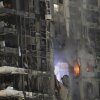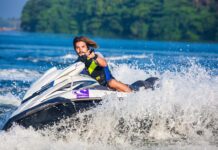
A satellite photo from the European firm Airbus shows the aftermath of a strike by Israel on a building that houses centrifuges at Iran’s Natanz nuclear facility. Open Source Centre/Airbus Defence and Space hide caption
toggle caption
Open Source Centre/Airbus Defence and Space
As part of a broad strike on Iran, Israel has attacked several of the country’s key nuclear facilities.
The first and most visible strike took place in the opening hours of the Israeli air campaign, which began overnight on Thursday. In a statement the Israeli military said that fighter jets had struck Iran’s largest enrichment facility at Natanz. “As part of the strikes, the underground area of the site was damaged. This area contains a multi-story enrichment hall with centrifuges, electrical rooms, and additional supporting infrastructure,” the statement read in part.

Middle East crisis — explained
Iran attacks Israel in retaliation, killing at least 3 and injuring dozens of others
Video posted online and verified by NPR showed black smoke billowing from the Natanz site early Friday morning local time. A set of images from the commercial satellite company Airbus showed damage to the main electrical substation at the facility and to buildings used to assemble and run centrifuges.
By Friday afternoon, there were additional reports of Israeli strikes near Iran’s other main enrichment facility at Fordow, and at Isfahan, which is also home to a nuclear research complex. So far, little is known about those strikes, which have taken place in the second night of fighting.
Loading…
In a statement, the Atomic Energy Organization of Iran said that the attack at the Natanz plant caused damage but that no radioactive or chemical contamination had leaked outside the site.
Rafael Mariano Grossi, the head of the International Atomic Energy Agency, condemned the attack.
“I have repeatedly stated that nuclear facilities must never be attacked, regardless of the context or circumstances,” Grossi said during a meeting of the agency’s board of governors.
The Natanz facility has been at the center of Iran’s nuclear program for decades. According to the IAEA, which has been monitoring activities at the site for the past several years, Iran has recently been using thousands of centrifuges to enrich uranium to 60%, far above the levels normally used in civilian nuclear reactors. The agency says that Iran has stockpiled more than 400 kilograms of the highly enriched material, enough by some estimates to quickly build around 10 nuclear weapons.
⭕️ IAF fighter jets, guided by precise intelligence, struck the Iranian regime’s uranium enrichment site in the Natanz area overnight. This is the largest uranium enrichment site in Iran, which has operated for years to achieve nuclear weapons capability and houses the… pic.twitter.com/JVLIZFHwLm
— Israel Defense Forces (@IDF) June 13, 2025
It’s unclear how quickly that material could practically be converted into bombs. During the enrichment process, the uranium is stored as a gas. It must be separated and converted into metal, which in turn must be fashioned into components for a nuclear device. Iran had a covert program to research such a weapon in the early 2000s, but it has never built a nuclear weapon before, and has said publicly it has no intentions to pursue one.
In a statement shortly after the strike, Prime Minister Benjamin Netanyahu said that Israel believed Iran had recently restarted its program to build a nuclear weapon. “If not stopped, Iran could produce a weapon in a very short time,” he said in prepared remarks shortly after the strike. The operation’s goal, Netanyahu stated, was to “strike at the heart of Iran’s nuclear enrichment program.”
Middle East
What Is Known About Iran’s Nuclear Capabilities
Preliminary analysis of satellite imagery at the site suggests the damage from the first wave of attacks was actually limited, according to Jeffrey Lewis, a professor at the Middlebury Institute of International Studies who has tracked Iran’s program.
Images from satellite company Airbus showed damage to several buildings at the Natanz site that are used to assemble centrifuges. The images also showed damage to support equipment, including an electrical substation and buildings that may provide power and access to the underground structures at the site.
لحظاتی پیش صدای ۲ انفجار از محدودهٔ سایت فردو به گوش رسید و ۲ نقطه از سطح زمین در محدوده فردو هدف قرار گرفته شده است.
سایت اتمی فردو در عمق چندصد متری زمین قرار دارد. pic.twitter.com/8PyJ8Bq2sQ
— خبرگزاری فارس (@FarsNews_Agency) June 13, 2025
“That’s likely to disrupt operations at the plant, but crucially, what they didn’t do was find a way to destroy the thousands of centrifuges that are buried underground,” Lewis says.

Ukraine invasion — explained
The bruising artillery battle in Ukraine has left a scar that is visible from space
Lewis also saw no evidence that Israel had struck at tunnels deep beneath a nearby mountain. Iran was reportedly digging those tunnels to create a more fortified facility for its centrifuges. In recent days it had pledged that it would accelerate development of a third centrifuge site, possibly in the mountain facility.
Lewis says he wonders whether military force can truly eliminate Iran’s nuclear program. In the end, he says, there is no single facility or scientist that holds the key to the entire nuclear enterprise in Iran.
“Unless the Israelis can keep bombing them indefinitely,” he says, “they will always have the ability to technically reconstitute the program if they make a decision to do so.”












